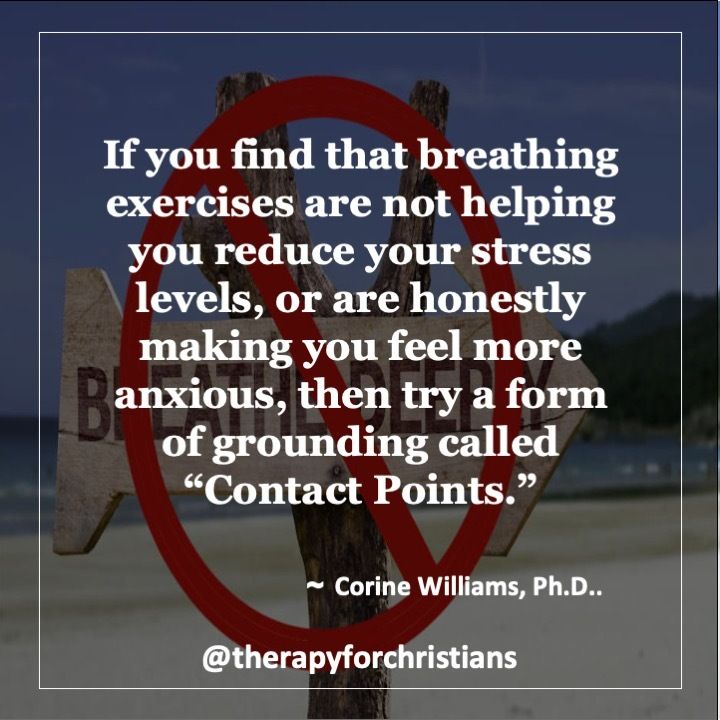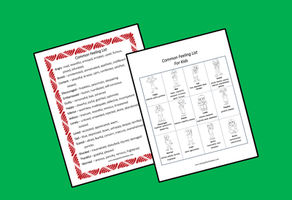
Deep breathing is one of the first things you are asked to do when you're anxious but it doesn’t always work. If you’ve ever tried a deep breathing exercise and felt like it didn’t help much or it actually made you feel worse, you are not alone.
 Like this content on FacebookWhile therapists know that deep breathing can work, they also know that different people respond in different ways. Yes, it has helped millions of people feel less anxious, but it also makes some feel worse and there are a few different reasons for that.
Like this content on FacebookWhile therapists know that deep breathing can work, they also know that different people respond in different ways. Yes, it has helped millions of people feel less anxious, but it also makes some feel worse and there are a few different reasons for that.
If you find that breathing exercises are not helping you reduce your stress levels, or are honestly making you feel more anxious, this blog post is for you.
Why Does Deep Breathing Usually Help Anxiety & Stress
There are many reasons why deep breathing usually helps anxiety and stress.
For example, when we’re anxious or stressed, our breathing becomes shallow and rapid. This can lead to feelings of dizziness, lightheadedness, and even hyperventilation. Breathing deeply in this case sends a signal to our brain that we are safe and everything is okay. This relaxed state then allows our body to release tension and stress.
Deep breathing also increases the oxygen supply to our brains, which helps to calm our nervous system, plus it’s a form of meditation, which has been shown to reduce anxiety and stress.
Why Deep Breathing Makes Anxiety Worse
With the amount of research suggesting deep breathing can and will help with stress and anxiety, why are so many people struggling? Why does deep breathing help some people while making others feel even worse?
There are a few different reasons for this, but here are the most common:
Deep Breathing May Be Triggering Traumatic Memories
If you're living with trauma and don't feel safe in your body, breathing exercises that make you focus inward can be really upsetting and even dangerous. Deep breathing in this case can retraumatize your mind and body. Therefore, making you feel worse.
You are Breathing Deeply but Fast
Deep breathing requires you to breathe both slowly and deeply. Breathing deeply fast can actually make you take in way too much oxygen causing you to hyperventilate instead of calming down. This is a mistake lots of people make when they practice deep breathing, which is why they feel worse.
You Only Practice Deep Breathing When You Are Anxious or Stress
Most people forget to practice deep breathing when they’re calm and therefore do it wrong when they are anxious. Practicing deep breathing only when you’re in a stressed or anxious state will most definitely make you feel worse as it is common to feel more anxious or upset when you try to force yourself to feel relaxed and don’t see results.
Breathing Exercises Just Aren’t for You
Sometimes things will work for some people and not for others and that’s okay. If breathing exercises aren’t working for you, another relaxation technique will, you just have to keep trying and not give up until you find something that works. One relaxation technique you can try that might work when deep breathing doesn’t is the contact point exercise. More on that below.
Try The Contact Point Exercise When Breathing Makes Anxiety Worse
There are several reasons the contact point exercise can be helpful even when breathing makes anxiety worse.
It can ground you in the present moment and break the cycle of anxious thoughts. It can help to increase your awareness of your body and how it feels to be in a relaxed state. And it can help to increase your confidence in your ability to cope with anxiety.
These reasons alone are enough to try the contact point exercise, but there’s more.
Why Focusing On Contact Points Reduces Anxiety and Stress
Firstly, your body is always in contact with something so you have a portable tool to use every time you feel stressed or anxious no matter where that is.
Secondly, choosing to nonjudgmentally redirect your attention back to the sensations of contact when your attention wanders helps strengthen your attentional control, which is an exercise that helps combat racing thoughts.
Thirdly, focusing on sensations of contact rather than distressing thoughts enables you to focus your attention on something that is neutral and doesn’t amplify negative emotions. Last but not least, the support you feel from the ground and the chair sends a signal to the survival brain and nervous system that you’re grounded, stable, and safe. This will cause the survival brain to reduce brain hyperactivity and stress arousal.
Ready to try the contact point exercise? Here’s how to do it.
The Contact Point Exercise
The contact point exercise was developed by Elizabeth Stanley and I modified it for a Christian audience. My version is below (you can also download it as a PDF). The best way to practice this exercise is by listening to it. Therefore, we recommend that you record yourself reading the below exercise out-loud or download our recording of this mediation for a minimum gift of 99cents or more.
These are the instructions for the contact point exercise.
- Find a comfortable place where you can sit and have both feet flat on the ground, about shoulders width apart. (long pause)
- If it feels comfortable to you, close your eyes; if not, direct your gaze at the ground in front of you. Sit so that your spine is upright yet relaxed. Sometimes the easiest way to achieve this posture is to push your butt back in the chair, crunch your shoulders up by your ears for a moment, and then allow them to drop, with your arms and hands resting in your lap. (long pause)
- As you settle in the chair that God has so graciously provided you, (long pause) notice the contact between your feet on the ground He created supporting you, (pause) You’re aiming for the felt sense of this support, in your body, rather than thinking about or analyzing this support. (long pause)
- Notice the contact between the backs of your legs against the chair, your lower back against the chair. (pause) and between the soles of your feet and the floor. (pause) If you have trouble feeling your feet, you can gently wiggle your toes or press your feet into the ground. (pause). And see if you can let go and settle in the chair into this very moment knowing that God is with you. (long pause)
- Just notices how God is allowing the chair to support you. (long pause) He is allowing the ground to support you without you having to do anything at all. (long pause)
- Just really feel the support of the chair holding your body in this moment with God. (pause)
- As you let go and settle further into this moment with God, take your attention and scan your whole body. (pause) Noticing if there are any places you are holding onto any tension or tightness. (long pause)
- If you notice any tension or tightness, just bring your awareness there, you can just let go and give it to God.
- Turn your attention to your eyes and eyebrows, (pause) your jaw, (pause) your neck and shoulders, (pause) your arms and hands, (pause) your legs, and feet. (long pause)
- Without trying to make anything particular happen, just noticing if you can let go and allow God to release any tension or tightness.(pause) He may or may not, but either outcome is perfectly fine and in God’s plan. (long pause)
- Now, bring your attention back to the physical sensations of contact between your body and your surroundings. You may notice things like pressure, hardness, softness, heat, coolness, tingling, numbness, sweatiness, or dampness. (long pause)
- And when you feel ready, bringing your attention back to that place of contact between the chair God has provided you and your legs, (pause) the chair and your back, (pause) your feet and the ground. (pause) Notice if there's one of these places where you feel that contact most strongly. (long pause)
- And then keeping your attention at that place of contact knowing that God is right here with you and has given you everything you need. (long pause)
- Allow God to allow your body and your mind this period of time to help settle the nervous system. (pause) Feeling that support if your attention wanders off, just noticing it's wandered and gently guiding it back to this place of contact. (long pause)
- Really feeling the chair that God has provided for you and the ground He created supporting you without you having to do anything at all. (long pause)
- Listen to whatever your body wants or needs in this moment and go ahead and do that as your body settles even more into this contact with the chair and the floor. (Extra-long pause)
- And now I invite you to open your attention wide again and notice if anything has changed as you have been doing this exercise. Thank God for this moment. (long pause)
- Is anything different in the body? (long pause)
- Is anything different in the mind? (long pause)
- Just notice any changes these few minutes, allowing the body and mind to settle, being held by the chair that God has provided for you and the ground He created supporting you. (long pause)
- Allow God to regulate your nervous system. (long pause)
- This concludes the contact point exercise.
Other Facts about The Contact Point Exercise
When you first start practicing the above contact point exercise, it is recommended that you practice at least once each day. Just like any skill, it is best to practice when you do not need the skills so that when you do need the skill you will be more effective in using the skill. Some people like to use this this exercise as a transition between different phases of the day, such as upon awakening, before engaging in reading the Bible, after getting home from work, or at bedtime.
I recommend doing this exercise while seated in a chair for the first few weeks. You can, however, do this exercise while standing or lying down. You will notice the sensations of contact between your feet and the ground while standing. You will notice sensations of contact between the entire backside of your body and the surface you're lying on while lying down. You can also practice lying on the floor with your legs up against a wall; this posture is particularly calming for the nervous system and aids in venous and lymphatic drainage. However, if you have high blood pressure, this is not a good practice posture.
It is also important to note, this exercise should be conducted from a place of nonjudgmental curiosity. The goal of this exercise is to simply notice what is going on in your body at any given moment. Remember your body is a wonderful gift from God, as you begin to connect with it more, you can more easily identify the messages your body is sending you.
About the Author:
 Corine Williams, Ph.D. is Clinical Psychologist that is currently seeing clients in the States of Maryland, New Jersey, and New York. You can find out more about her practice by visiting www.therapyforchristians.com/corinewilliams. In addition to providing individual therapy, Dr. Williams is also passionate about writing books and designing merchandise that educate, uplift, and normalize mental health subject in the Christian community. You can find out more about her at www.booksbycorine.com or by visiting her amazon profile here: https://www.amazon.com/Corine-Hyman/e/B00AWZ5FL2
Corine Williams, Ph.D. is Clinical Psychologist that is currently seeing clients in the States of Maryland, New Jersey, and New York. You can find out more about her practice by visiting www.therapyforchristians.com/corinewilliams. In addition to providing individual therapy, Dr. Williams is also passionate about writing books and designing merchandise that educate, uplift, and normalize mental health subject in the Christian community. You can find out more about her at www.booksbycorine.com or by visiting her amazon profile here: https://www.amazon.com/Corine-Hyman/e/B00AWZ5FL2
Help us increase mental health awareness in the Christian community by donating through our paypal link here: www.paypal.com/therapyforchristians, joining our mailing list by clicking below, or join our provider list here: Provider listing
Disclaimer: the information, including but not limited to, text, graphics, images and other material contained on this article are for informational purposes only. No material on this site is intended to be a substitute for professional medical advice, diagnosis or treatment. If you are looking for a Christian counselor near you, please check out our directory located here: Christians Therapist Near Me
.png)











